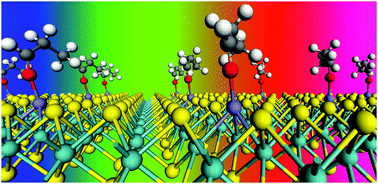Engineering of the interactions of volatile organic compounds with MoS2†
Abstract
We investigate the interactions between volatile organic compounds (VOCs, including ethanol, acetone and propanal) and pristine, defective and transition metal-functionalized MoS2 using the first-principles method. The sensitivity of MoS2-based chemical gas sensors could be drastically improved by transition metal functionalization. The VOCs exhibit physical adsorption on pure and sulfur-vacancy-defective MoS2 but stronger chemisorption on transition metal (TM) (Fe, Co, Pd) functionalized MoS2 together with larger adsorption energy and charge transfer. The band gaps of defective and transition metal functionalized MoS2 are smaller than that of perfect monolayer MoS2 and there are a few localized states inside. This also favors the adsorption of VOCs. The VOCs have the largest adsorption energies on the Fe functionalized MoS2 substrate. The adsorption of VOCs will reduce the total magnetic moments of the Fe and Co functionalized MoS2 substrates. Moreover the magnetic exchange coupling energies are variable in response to the adsorption of VOCs. The ferromagnetic coupling can be even reversed to anti-ferromagnetic coupling. This ferromagnetic to antiferromagnetic transition can be detected by a magnetic force microscope. Our work strongly suggests that MoS2 is a compelling and feasible candidate as a magnetic sensor for VOCs.



 Please wait while we load your content...
Please wait while we load your content...